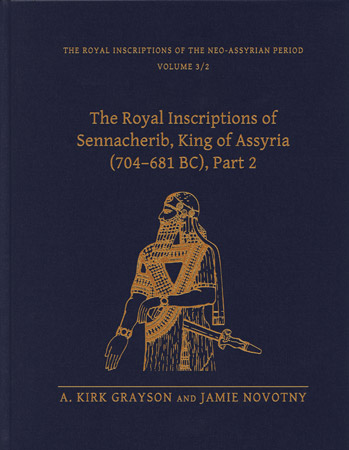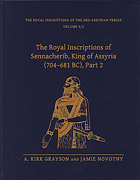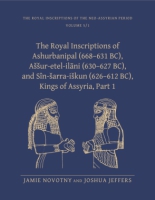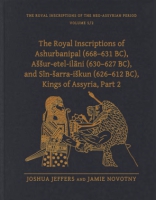
The Royal Inscriptions of Sennacherib, King of Assyria (704–681 BC), Part 2
A. Kirk Grayson and Jamie Novotny
The Royal Inscriptions of Sennacherib, King of Assyria (704–681 BC), Part 2
A. Kirk Grayson and Jamie Novotny
The Royal Inscriptions of Sennacherib, King of Assyria (704–681 BC), Part 2 (Royal Inscriptions of the Neo-Assyrian Period 3/2) provides reliable, up-to-date editions of 195 texts of Sennacherib, as well as 26 other late Neo-Assyrian inscriptions that might belong to this king and 2 inscriptions of his family (including one of his wives, Tashmetu-sharrat). The volume contains historical inscriptions on bull and lion colossi from Nineveh, rock reliefs, stone horizontal prisms, and clay cylinders and prisms from other cities under Sennacherib’s authority (especially Ashur and Tarbisu); epigraphs on reliefs; and inscriptions on bricks, threshold slabs, door sockets, wall panels, stone blocks, beads, metal plating (including door bands); and drafts and copies of historical and building inscriptions written on clay tablets. Each text edition (with its English translation) is supplied with a brief introduction containing general information, a catalogue containing basic information about all exemplars, a commentary containing further technical information and notes, and a comprehensive bibliography.
- Description
- Table of Contents
- Links
RINAP 3/2 also includes: (1) a general introduction to the corpus of inscriptions and Sennacherib’s numerous building activities in Assyria (especially construction at Ashur); (2) several photographs of objects inscribed with texts of Sennacherib; (3) indices of museum and excavation numbers and selected publications; and (4) indices of proper names (Personal Names; Geographic, Ethnic, and Tribal Names; Divine, Planet, and Star Names; Gate, Palace, Temple, and Wall Names; and Object Names).
The RINAP Project is under the direction of G. Frame (University of Pennsylvania) and is supported by the National Endowment for the Humanities.
Introduction
1. Assyria
2. Northern and Northeastern Assyria
3. Assyria-Babylonia Border Region
4. Babylonia
5. Uncertain texts
6. Royal Women
Minor Variants and Comments
Index of Museum Numbers
Index of Excavation Numbers
Index of Names
Concordances of Selected Publications
Scores of Inscriptions are made available on Oracc.
Scores of inscriptions are made available on Oracc.
Mailing List
Subscribe to our mailing list and be notified about new titles, journals and catalogs.





